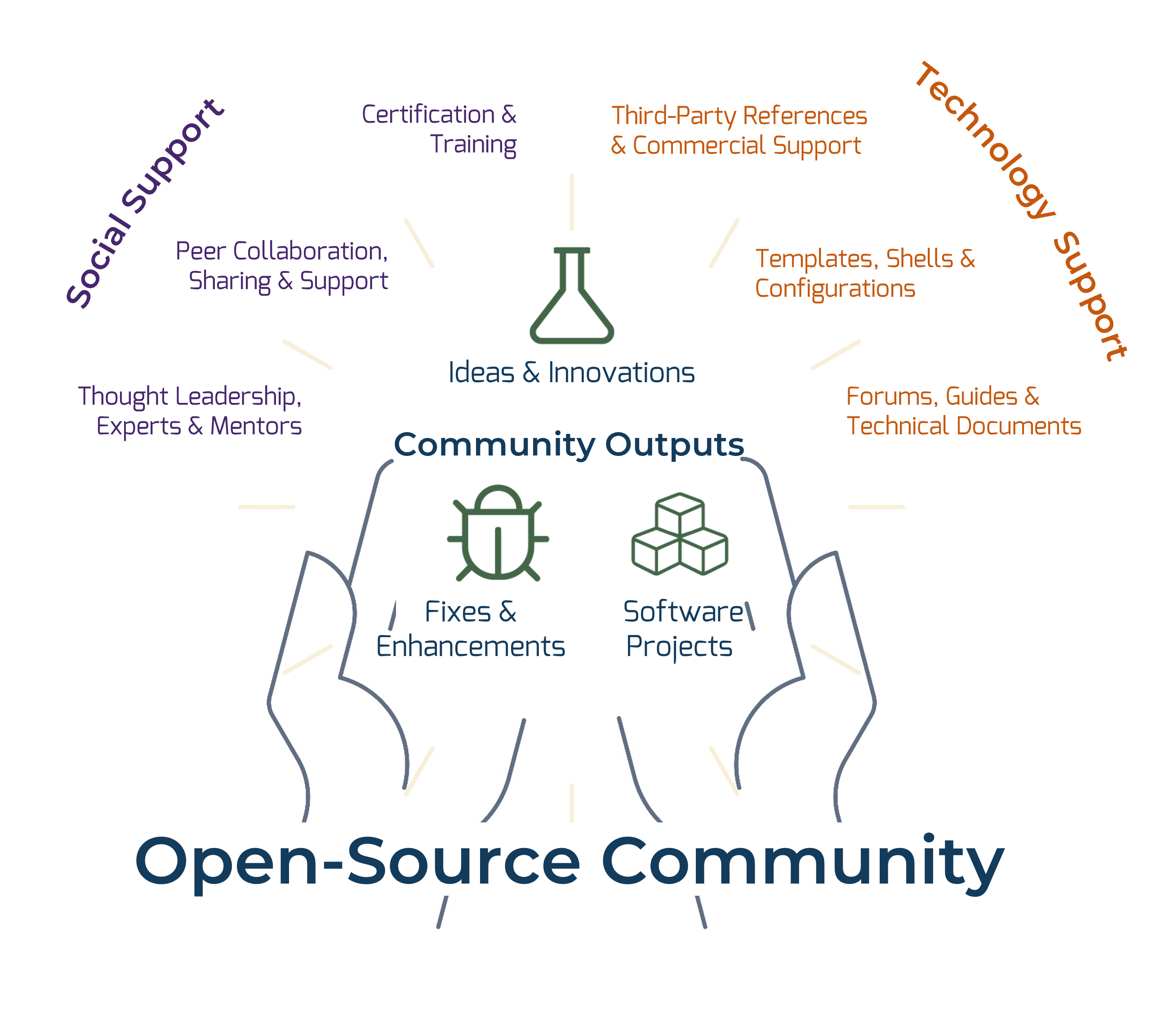Your organization is looking to invest in new software or a tool to solve key business and IT problems. They see open source as a viable option given the advertised opportunities and the popularity of many open-source projects, but they have concerns:
- Despite the longevity and broad adoption of open-source software, stakeholders are hesitant about its long-term viability and the costs of ongoing support.
- A clear direction and strategy are needed to align the expected value of open source to your stakeholders’ priorities and gain the funding required to select, implement, and support open-source software.
Our Advice
Critical Insight
- Position open source in the same light as commercial software. The continuous improvement and evolution of popular open-source software and communities have established a reputation for reliability in the industry.
- Consider open source as another form of outsource development. Open source is externally developed software where the code is accessible and customizable. Code quality may not align to your organization’s standards, which can require extensive testing and optimization.
- Treat open source as any internally developed solution. Configurations, integrations, customizations, and orchestrations of open-source software are often done at the code level. While some community support is provided, most of the heavy lifting is done by the applications team.
Impact and Result
- Outline the value you expect to gain. Discuss current business and IT priorities, use cases, and value opportunities to determine what to expect from open-source versus commercial software.
- Define your open-source selection criteria. Clarify the driving factors in your evaluation of open-source and commercial software using your existing IT procurement practices as a starting point.
- Assess the readiness of your team. Clarify the roles, processes, and tools needed for the implementation, use, and maintenance of open-source software.
Take the First Steps to Embrace Open-Source Software
Begin to understand what is required to embrace open-source software in your organization.
Analyst Perspective
With great empowerment comes great responsibilities.
Open-source software promotes enticing technology and functional opportunities to any organization looking to modernize without the headaches of traditional licensing. Many organizations see the value of open source in its ability to foster innovation, be flexible to various use cases and system configurations, and give complete control to the teams who are using and managing it.
However, open source is not free. While the software is freely and easily accessible, its use and sharing are bound by its licenses, and its implementation requires technical expertise and infrastructure investments. Your organization must be motivated and capable of taking on the various services traditionally provided and managed by the vendor.

Andrew Kum-Seun
Research Director,
Application Delivery and Application Management
Info-Tech Research Group
Executive Summary
Your ChallengeYour organization is looking to invest in new software or a tool to solve key business and IT problems. They see open source as a viable option because of the advertised opportunities and the popularity of many open-source projects. Despite the longevity and the broad adoption of open-source software, stakeholders are hesitant about its adoption, its long-term viability, and the costs of ongoing support. A clear direction and strategy is needed to align the expected value of open source to your stakeholders’ priorities and gain the funding required to select, implement, and support open-source software. |
Common ObstaclesYour stakeholders’ fears, uncertainties, and doubts about open source may be driven by misinterpretation or outdated information. This hesitancy can persist despite some projects being active longer than their proprietary counterparts. Certain software features, support capabilities, and costs are commonly overlooked when selecting open-source software because they are often assumed in the licensing and service costs of commercial software. Open-source software is often technically complicated and requires specific skill sets and knowledge. Unfortunately, current software delivery capability gaps impede successful adoption and scaling of open-source software. |
Info-Tech’s ApproachOutline the value you expect to gain. Discuss current business and IT priorities, use cases, and value opportunities to determine what to expect from open-source versus commercial software. Define your open-source selection criteria. Clarify the driving factors in your evaluation of open-source and commercial software using your existing IT procurement practices as a starting point. Assess the readiness of your team. Clarify the roles, processes, and tools needed for the implementation, use, and maintenance of open-source software. |
Insight Summary
Overarching Info-Tech Insight
Open source is as much about an investment in people as it is about technology. It empowers applications teams to take greater control over their technology and customize it as they see fit. However, teams need the time and funding to conduct the necessary training, management, and ongoing community engagement that open-source software and its licenses require.
- Position open source in the same light as commercial software.
The continuous improvement and evolution of popular open-source software and communities have established a trusting and reliable reputation in the industry. Open-source software quality and community support can rival similar vendor capabilities given the community’s maturity and contributions in the technology. - Consider open source another form of outsource development.
Open source is externally developed software where the code is accessible and customizable. Code quality may not align to your organization’s standards, which can require extensive testing and optimization. A thorough analysis of change logs, code repositories, contributors, and the community is recommended – much to the same degree as one would do with prospective outsourcing partners. - Treat open source as any internally developed solution.
Configurations, integrations, customizations, and orchestrations of open-source software are often done at the code level. While some community support is provided, most of the heavy lifting is done by the applications team. Teams must be properly resourced, upskilled, and equipped to meet this requirement. Otherwise, third-party partners are needed.
What is open source?
According to Synopsys, “Open source software (OSS) is software that is distributed with its source code, making it available for use, modification, and distribution with its original rights. … Programmers who have access to source code can change a program by adding to it, changing it, or fixing parts of it that aren’t working properly. OSS typically includes a license that allows programmers to modify the software to best fit their needs and control how the software can be distributed.”
What are the popular use cases?
- Programming languages and frameworks
- Databases and data technologies
- Operating systems
- Git public repos
- Frameworks and tools for AI/ML/DL
- CI/CD tooling
- Cloud-related tools
- Security tools
- Container technology
- Networking
Source: OpenLogic, 2022
Common Attributes of All Open-Source Software
- Publicly shared repository that anyone can access to use the solution and contribute changes to the design and functionality of the project.
- A community that is an open forum to share ideas and solution enhancements, discuss project direction and vision, and seek support from peers.
- Project governance that sets out guidelines, rules, and requirements to participate and contribute to the project.
- Distribution license that defines the terms of how a solution can be used, assessed, modified, and distributed.
Take the first steps to embrace open-source software
Begin to understand what is required to embrace open-source software in your organization.

State the Value of Open Source: Discuss current business and IT priorities, use cases, and value opportunities to determine what to expect from open-source versus commercial software.
Select Your Open-Source Software: Clarify the driving factors in your evaluation of open-source and commercial software using your existing IT procurement practices as a starting point.
Prepare for Open Source: Clarify the roles, processes, and tools needed for the implementation, use, and maintenance of open-source software.
Step 1.1: State the Value of Open Source

Activities
1.1.1 Outline the value you expect to gain from open-source software
This step involves the following participants:
- Applications team
- Product owner
Outcomes of this step:
- Value proposition for open source
- Potential open-source use cases
Use a canvas to frame your open-source evaluation

This canvas is intended to provide a single pane of glass to start collecting your thoughts and framing your future conversations on open-source software selection and adoption.
Record the results in the “Open-Source Canvas” tab in the Open-Source Readiness Assessment.
Open source presents unique software and tooling opportunities
Innovation
Many leading-edge and bleeding-edge technologies are collaborated and innovated in open-source projects, especially in areas that are beyond the vision and scope of vendor products and priorities.
Niche Solutions
Open-source projects are focused. They are designed and built to solve specific business and technology problems.
Flexible & Customizable
All aspects of the open-source software are customizable, including source code and integrations. They can be used to extend, complement, or replace internally developed code. Licenses define how open-source code should be and must be used, productized, and modified.
Brand & Recognition
Open-source communities encourage contribution and collaboration among their members to add functionality and improve quality and adoption.
Cost
Open-source software is accessible to everyone, free of charge. Communities do not need be consulted prior to acquisition, but the software’s use, configurations, and modifications may be restricted by its license.
However, myths continue to challenge adoption
- Open source is less secure or poorer quality than proprietary solutions.
- Open source is free from risk of intellectual property (IP) infringement.
- Open source is cheaper than proprietary solutions.
What are the top perceived barriers to using enterprise open source?
- Concerns about the level of support
- Compatibility concerns
- Concerns about inherent security of the code
- Lack of internal skills to manage and support it
Source: Red Hat, 2022

 Mature and Scale Product Ownership
Mature and Scale Product Ownership
 Evolve Your Software Development Lifecycle Into a Solution Delivery Lifecycle
Evolve Your Software Development Lifecycle Into a Solution Delivery Lifecycle
 Adopt Generative AI in Solution Delivery
Adopt Generative AI in Solution Delivery
 Boost Solution Delivery Throughput With AI
Boost Solution Delivery Throughput With AI
 Estimate Software Delivery With Confidence
Estimate Software Delivery With Confidence
 Select and Use SDLC Metrics Effectively
Select and Use SDLC Metrics Effectively
 Improve Application Development Throughput
Improve Application Development Throughput
 Activate Your Augmented Reality Initiative
Activate Your Augmented Reality Initiative
 Spread Best Practices With an Agile Center of Excellence
Spread Best Practices With an Agile Center of Excellence
 Perform an Agile Skills Assessment
Perform an Agile Skills Assessment
 Deliver on Your Digital Product Vision
Deliver on Your Digital Product Vision
 Mentoring for Agile Teams
Mentoring for Agile Teams
 Implement DevOps Practices That Work
Implement DevOps Practices That Work
 Deliver Digital Products at Scale
Deliver Digital Products at Scale
 Enhance Your Solution Architecture Practices
Enhance Your Solution Architecture Practices
 Define a Release Management Process to Deliver Lasting Value
Define a Release Management Process to Deliver Lasting Value
 2020 Applications Priorities Report
2020 Applications Priorities Report
 Agile Readiness Assessment Survey
Agile Readiness Assessment Survey
 Define a Sourcing Strategy for Your Development Team
Define a Sourcing Strategy for Your Development Team
 Define the Role of Project Management in Agile and Product-Centric Delivery
Define the Role of Project Management in Agile and Product-Centric Delivery
 Implement a Transformative IVR Experience That Empowers Your Customers
Implement a Transformative IVR Experience That Empowers Your Customers
 Create an Agile-Friendly Project Gating and Governance Approach
Create an Agile-Friendly Project Gating and Governance Approach
 Develop Your Agile Approach for a Successful Transformation
Develop Your Agile Approach for a Successful Transformation
 Take the First Steps to Embrace Open-Source Software
Take the First Steps to Embrace Open-Source Software
 Enable Product Delivery – Executive Leadership Workshop
Enable Product Delivery – Executive Leadership Workshop